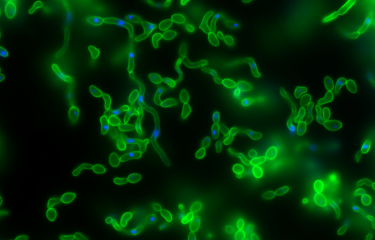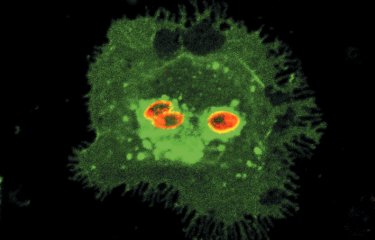Painful periods, menstruation, endometriosis, diagnostic odyssey – Camille Berthelot is not afraid to delve into topics that are sometimes seen as taboo but affect a large part of the world's population. She specializes in comparative genomics of species and leads her own group at the Institut Pasteur. She and her team are currently working to find a biological marker that could be used for early and easy diagnosis of endometriosis. As a geneticist, another broader question also interests her: how and why did menstruation develop in primates during evolution?
An explorer of the human genome
Camille's colleagues say that their research group leader is always cheerful, composed, conscientious, determined and happy to help. When we ask Camille who guided and inspired her in her research career, she immediately breaks into a wide smile and says:
"I wanted to be the Indiana Jones of biology!"
Indiana Jones – Indy to his friends – left a real impression on Camille during her childhood and gave her a taste for adventure and a fascination for archaeological remains. In Raiders of the Lost Ark, the character played by Harrison Ford is a university professor and archaeologist. For Camille, studying the mysterious human and genetic characteristics that emerged during the lengthy process of evolution is a way of understanding and reconnecting with our ancient past.

I must have been 7 or 8 when it was on TV. My mum was a fan of the Indiana Jones films! I was fascinated by archaeological excavations and the idea that ancient objects can help us to understand the past. A few years later I also loved Jurassic Park, for the same reasons."
At the end of her biology studies at the Ecole Normale Supérieure in Lyon, she chose the "Genomics and Evolution" option. Although she loved the variety of subjects taught on the biology course, it was this discipline that she specialized in for her PhD in bioinformatics, with a thesis on the comparative evolution of fish genomes.
For her postdoctoral fellowship, she pursued her research in the UK, at the European Bioinformatics Institute (EMBL-EBI) in Cambridge. It was there that she acquired a more detailed knowledge of computational biology and developed her own programs using R or Python to analyze and compare gene evolution.
Uterus, menstruation, endometriosis
After her postdoc, Camille began to reflect on a novel subject that she was keen to explore further.
One day she had a conversation with a friend who suffered from endometriosis, and she began to delve into the scientific literature about the condition. It was a real eye-opener!
« From a societal and medical perspective there is a lot of progress to be made: one in ten women suffer from different forms of this gynecological disease, which is sometimes extremely debilitating. And diagnosis takes a long time – seven years on average .»
It is a diagnostic odyssey, and the pain experienced is not always taken seriously. It is often when women want to have children that doctors diagnose endometriosis, which is thought to lead to fertility problems in 50% of cases.
To date, there is no easy way of diagnosing this chronic condition.
So Camille has set herself the challenge of developing a biological marker to facilitate diagnosis. Her team has launched a study on a small cohort of female volunteers, some of whom have endometriosis. The volunteers will send the scientists menstrual flow samples. The uterine tissue they contain will be used to collect and then compare the messenger RNA from these two population types.
Ideally, Camille would like to see a situation in which women can go to any medical testing laboratory and simply submit a sample. This non-invasive technique could facilitate the diagnosis of endometriosis or some forms of endometrial cancer. A study is currently under way in collaboration with Cochin Hospital and the German Cancer Research Center in Heidelberg.
Menstruation: an evolutionary enigma
A second, longer-term research topic is also being explored by Camille's research group. Menstruation emerged during the evolution of primates around 30 million years ago. In the evolutionary chain, our primate ancestors did not menstruate. We can see this today: small Old World monkeys that live in South America, like marmosets and squirrel monkeys, do not menstruate, whereas great apes – orangutans, gorillas and chimpanzees – do menstruate.

Why did this adaptation emerge when it consumes so much energy? What is the advantage of losing tissue and blood every 28 days?
The theory developed by Camille Berthelot and her team is that the uterus evolves rapidly because it is at the interface between two individuals, the mother and the embryo. Each adapts and optimizes resources – the embryo to survive, and the mother for future pregnancies. So the two individuals need to coevolve to make sure they can continue to interact successfully, while both safeguarding their own advantages and evolutionary interests.
It is thought that menstruation emerged in connection with this evolutionary compromise: it is the result of a novel cell differentiation mechanism in the endometrium, which supports firm implantation of the embryo in the uterus under the control of maternal hormones, but on the flip side also causes the tissue to detach in the absence of implantation.
In a bid to elucidate this question, Camille and her team are comparing the genomes of different primates, some of which menstruate, based on genetic data available to the scientific community. They are also studying biological samples from primates to compare genome expression in the uterus during the menstrual cycle. The team is seeking to identify novel cellular mechanisms that emerged during the evolution of menstruation and changed the way in which the uterus functions in species that menstruate. They are interested in the impact of these novel mechanisms on embryo implantation and placental development.
|
Endometriosis is a chronic gynecological condition in which the tissue that normally lines the uterus, known as the endometrium, develops outside the uterus. Endometriosis can lead to a range of painful symptoms and fertility problems. Normally, the endometrium thickens each month in preparation for a possible pregnancy. If no fertilization occurs, the endometrium detaches and causes menstruation. In endometriosis, endometrial tissue is found in other parts of the abdomen, such as the ovaries, the fallopian tubes, the ligaments supporting the uterus, the peritoneum (the lining of the abdominal cavity) or other organs. Endometriosis is often associated with symptoms such as intense pelvic pain during periods, painful sexual intercourse, back pain, heavy menstrual bleeding, digestive and urinary issues, and fertility problems. es douleurs lombaires, des saignements menstruels abondants, des troubles digestifs et urinaires, ainsi que des problèmes de fertilité. |
Key dates in Camille Berthelot's career
1985 – born in Toulouse
2004 – started at ENS Lyon
2007 – passed the "agrégation" (high-level teaching qualification) in life, earth and universe sciences
2012 – graduated with a PhD from ENS Paris
2016 – recruited as a research associate at Inserm
2019 – obtained an ERC Starting Grant from the European Research Council to study the evolution of menstruation in primates
This research is part of the INCEPTION project
2021 – start of the Comparative Functional Genomics team at the Institut Pasteur






